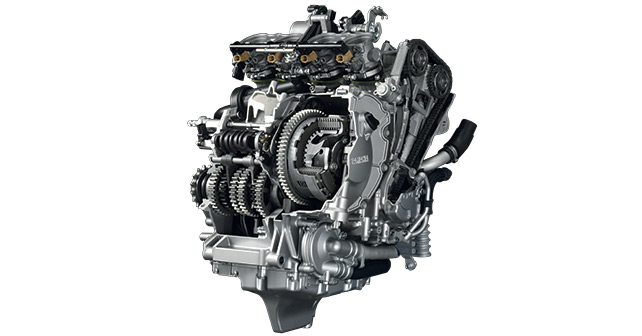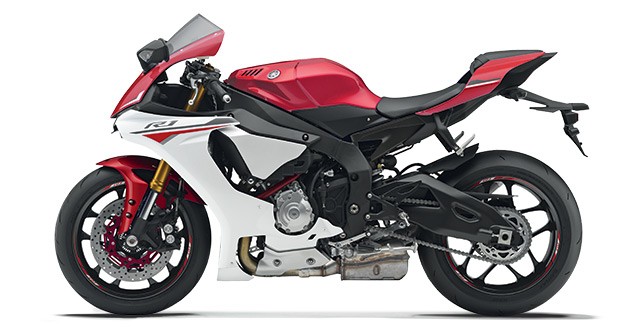Yamaha’s next generation R1 is here. Inspired heavily by the MotoGP YZR M-1 bike, both in terms of styling and electronics, the successor to Yamaha’s legendary flagship supersport bike belts out 200bhp, weighs a little less than 200kgs, and can take your riding to an entirely new level.
Seventeen years. That’s how long it’s been since the launch of the first YZF-R1 – the motorcycle that shook the field of the litre-class sports bikes. According to the initial technical data circulated by the company, the new R1 should be just as innovative – and so it becomes a serious problem for its direct competitors. Indeed, the four-cylinder Yamaha doesn’t share a single part with its previous version. Even so, some aspects commonly tied to the Iwata sports bike have been retained – for instance, the crossplane crankshaft engine and Deltabox chassis. The result is striking. 200bhp. A dry weight of 179kgs, and a load of electronic features to make the engineers of Valentino Rossi’s M1 race bike green with envy.
The four-stroke, in-line four-cylinder 998cc engine exploits an innovative crankshaft that keeps the crank handles staggered by 90-degrees – obtaining an ‘irregular’ burst sequence (270°-180°-90°-180°) that makes throttle control easier. Also new are the titanium fracture-split conrods and the aluminium pistons – even the bore/stroke ratio changes (79.0 x 50.9mm). In general, the whole R1 engine head has been redesigned – featuring a more efficient intake and exhaust, as well as bigger valves (now controlled by finger followers, instead of the cams of the camshaft).
Inevitably, the whole power supply system has undergone a revision. The air box increases by 23% (the inlet trumpets of variable height YCC-I, Yamaha Chip Controlled Intake, are still there) while the four ‘low’ injectors now feature 12 bidirectional nozzles. The latter work along with the four secondary rear injectors located above the trumpets, which start working at higher revs. The throttle butterfly valves, instead, are controlled by the YCCT system (Yamaha Chip Controlled Throttle).
ELECTRONICS PREVAIL
The engine is fixed to the chassis (a twin spar diagonal Deltabox) only in four points. Compared to the previous version, the wheelbase is 10mm shorter and the swingarm is 15mm shorter. But the steering angle, and the offset do not vary. As on the M1 MotoGP bike, the air box breathes through an air intake located on the front – the channel for which crosses the steering head.
The front forks and the rear suspension are traditional (and completely adjustable), while the aluminium tank, the cast magnesium wheels, and the ABS Unified Brake System stand out. Through the ABS, we enter its ‘electronic universe.’ The new YZF-R1 adopts a six-axis inertial measurement unit (IMU), which uses three gyro sensors to measure pitch, roll and yaw, and three gravity sensors to register acceleration from front to back, left to right, and top to bottom. On the base of this information, at a frequency of 125-times per second, the IMU is able to determine the bike position and behaviour. The data is transmitted by the Controller Area Network (CAN) to the ECU, which executes real-time calculations and sets up the R1’s electronics – the Traction Control System (TCS), to the Slide Control System, which manages everything from driving wheel slip, to the Lift Control System (LIF), to the Launch Control System (LCS), to the quick shift QSS, and to the four riding modes.



YZF-R1M: READY TO COMPETE
A more sophisticated and upgraded R1 Special model, called the YZF-R1M, will be available for riders involved in competition and the more demanding amateurs. It features fully electronic, active Öhlins suspension, named Electronic Racing Suspension (ERS). They constantly receive data from the IMU, which regulates the electronics and constantly adjusts the hydraulic brake pressure for the ideal ride. But there’s something more – the R1M will also feature a Communication Control Unit (CCU - a sort of Wi-Fi data logging system), a carbon fibre fairing, and tyres developed specially by Bridgestone (with the rear tyre wider at 200/55, while the standard version features a 190/55)
© Riproduzione riservata



































Write your Comment